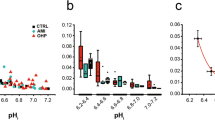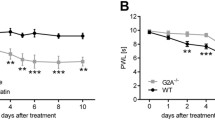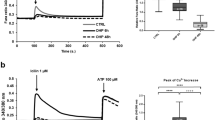Abstract
Oxaliplatin is important for treating colorectal cancer. Although oxaliplatin is highly effective, it has severe side effects, of which neurotoxicity in dorsal root ganglion (DRG) neurons is one of the most common. The key mechanisms of this neurotoxicity are still controversial. However, disturbances of calcium homeostasis in DRG neurons have been suggested to mediate oxaliplatin neurotoxicity. By using whole-cell patch-clamp and current-clamp techniques, as well as immunocytochemical staining, we examined the influence of short- and long-term exposure to oxaliplatin on voltage-gated calcium channels (VGCC) and different VGCC subtypes in small DRG neurons of rats in vitro. Exposure to oxaliplatin reduced VGCC currents (ICa(V)) in a concentration-dependent manner (1–500 μM; 13.8–63.3%). Subtype-specific measurements of VGCCs showed differential effects on ICa(V). While acute treatment with oxaliplatin led to a reduction in ICa(V) for P/Q-, T-, and L-type VGCCs, ICa(V) of N-type VGCCs was not affected. Exposure of DRG neurons to oxaliplatin (10 or 100 μM) for 24 h in vitro significantly increased the ICa(V) current density, with a significant influence on L- and T-type VGCCs. Immunostaining revealed an increase of L- and T-type VGCC protein levels in DRG neurons 24 h after oxaliplatin exposure. This effect was mediated by calcium-calmodulin-protein kinase II (CaMKII). Significant alterations in action potentials (AP) and their characteristics were also observed. While the amplitude increased after oxaliplatin treatment, the rise time and time-to-peak decreased, and these effects were reversed by treatment with pimozide and nimodipine, which suggests that VGCCs are critically involved in oxaliplatin-mediated neurotoxicity.








Similar content being viewed by others
References
Misset JL, Bleiberg H, Sutherland W, Bekradda M, Cvitkovic E (2000) Oxaliplatin clinical activity: a review. Crit Rev Oncol Hematol 35(2):75–93
Wilson RH, Lehky T, Thomas RR, Quinn MG, Floeter MK, Grem JL (2002) Acute oxaliplatin-induced peripheral nerve hyperexcitability. J Clin Oncol 20(7):1767–1774. https://doi.org/10.1200/JCO.2002.07.056
Thompson SW, Davis LE, Kornfeld M, Hilgers RD, Standefer JC (1984) Cisplatin neuropathy. Clinical, electrophysiologic, morphologic, and toxicologic studies. Cancer 54(7):1269–1275
Dzagnidze A, Katsarava Z, Makhalova J, Liedert B, Yoon MS, Kaube H, Limmroth V, Thomale J (2007) Repair capacity for platinum-DNA adducts determines the severity of cisplatin-induced peripheral neuropathy. J Neurosci 27(35):9451–9457. https://doi.org/10.1523/JNEUROSCI.0523-07.2007
Windebank AJ, Grisold W (2008) Chemotherapy-induced neuropathy. J Peripher Nerv Syst 13(1):27–46. https://doi.org/10.1111/j.1529-8027.2008.00156.x
Podratz JL, Knight AM, Ta LE, Staff NP, Gass JM, Genelin K, Schlattau A, Lathroum L et al (2011) Cisplatin induced mitochondrial DNA damage in dorsal root ganglion neurons. Neurobiol Dis 41(3):661–668. https://doi.org/10.1016/j.nbd.2010.11.017
Xing C, Chen J, Xu H (1999) Changes in [Ca2+]i and IP3 levels in the process of cisplatin-induced apoptosis of gastric carcinoma. Zhonghua Zhong Liu Za Zhi [Chin J Oncol] 21(4):256–258
Splettstoesser F, Florea AM, Busselberg D (2007) IP(3) receptor antagonist, 2-APB, attenuates cisplatin induced Ca2+-influx in HeLa-S3 cells and prevents activation of calpain and induction of apoptosis. Br J Pharmacol 151(8):1176–1186. https://doi.org/10.1038/sj.bjp.0707335
Ertel EA, Campbell KP, Harpold MM, Hofmann F, Mori Y, Perez-Reyes E, Schwartz A, Snutch TP et al (2000) Nomenclature of voltage-gated calcium channels. Neuron 25(3):533–535
Lacinova L (2005) Voltage-dependent calcium channels. Gen Physiol Biophys 24(Suppl 1):1–78
Kawashiri T, Egashira N, Kurobe K, Tsutsumi K, Yamashita Y, Ushio S, Yano T, Oishi R (2012) L type Ca(2)+ channel blockers prevent oxaliplatin-induced cold hyperalgesia and TRPM8 overexpression in rats. Mol Pain 8:7. https://doi.org/10.1186/1744-8069-8-7
Baumgarten LB, Toscas K, Villereal ML (1992) Dihydropyridine-sensitive L-type Ca2+ channels in human foreskin fibroblast cells. Characterization of activation with the growth factor Lys-bradykinin. J Biol Chem 267(15):10524–10530
Barrett CF, Rittenhouse AR (2000) Modulation of N-type calcium channel activity by G-proteins and protein kinase C. J Gen Physiol 115(3):277–286
Leo M, Schmitt LI, Erkel M, Melnikova M, Thomale J, Hagenacker T (2017) Cisplatin-induced neuropathic pain is mediated by upregulation of N-type voltage-gated calcium channels in dorsal root ganglion neurons. Exp Neurol 288:62–74. https://doi.org/10.1016/j.expneurol.2016.11.003
Fernyhough P, Calcutt NA (2010) Abnormal calcium homeostasis in peripheral neuropathies. Cell Calcium 47(2):130–139. https://doi.org/10.1016/j.ceca.2009.11.008
McCallum JB, Kwok WM, Mynlieff M, Bosnjak ZJ, Hogan QH (2003) Loss of T-type calcium current in sensory neurons of rats with neuropathic pain. Anesthesiology 98(1):209–216
Fuchs A, Rigaud M, Hogan QH (2007) Painful nerve injury shortens the intracellular Ca2+ signal in axotomized sensory neurons of rats. Anesthesiology 107(1):106–116. https://doi.org/10.1097/01.anes.0000267538.72900.68
Bourinet E, Alloui A, Monteil A, Barrere C, Couette B, Poirot O, Pages A, McRory J et al (2005) Silencing of the Cav3.2 T-type calcium channel gene in sensory neurons demonstrates its major role in nociception. EMBO J 24(2):315–324. https://doi.org/10.1038/sj.emboj.7600515
Ikeda H, Heinke B, Ruscheweyh R, Sandkuhler J (2003) Synaptic plasticity in spinal lamina I projection neurons that mediate hyperalgesia. Science 299(5610):1237–1240. https://doi.org/10.1126/science.1080659
Latham JR, Pathirathna S, Jagodic MM, Choe WJ, Levin ME, Nelson MT, Lee WY, Krishnan K et al (2009) Selective T-type calcium channel blockade alleviates hyperalgesia in ob/ob mice. Diabetes 58(11):2656–2665. https://doi.org/10.2337/db08-1763
Hagenacker T, Splettstoesser F, Greffrath W, Treede RD, Busselberg D (2005) Capsaicin differentially modulates voltage-activated calcium channel currents in dorsal root ganglion neurones of rats. Brain Res 1062(1–2):74–85. https://doi.org/10.1016/j.brainres.2005.09.033
Liang X, Huang Y (2000) Intracellular free calcium concentration and cisplatin resistance in human lung adenocarcinoma A549 cells. Biosci Rep 20(3):129–138
Tomaszewski A, Busselberg D (2007) Cisplatin modulates voltage gated channel currents of dorsal root ganglion neurons of rats. Neurotoxicology 28(1):49–58. https://doi.org/10.1016/j.neuro.2006.07.005
Busselberg D, Platt B, Michael D, Carpenter DO, Haas HL (1994) Mammalian voltage-activated calcium channel currents are blocked by Pb2+, Zn2+, and Al3+. J Neurophysiol 71(4):1491–1497
Authier N, Gillet JP, Fialip J, Eschalier A, Coudore F (2003) An animal model of nociceptive peripheral neuropathy following repeated cisplatin injections. Exp Neurol 182(1):12–20. https://doi.org/10.1016/S0014-4886(03)00003-7
Deuis JR, Lim YL, de Sousa SR, Lewis RJ, Alewood PF, Cabot PJ, Vetter I (2014) Analgesic effects of clinically used compounds in novel mouse models of polyneuropathy induced by oxaliplatin and cisplatin. Neuro-Oncology 16(10):1324–1332. https://doi.org/10.1093/neuonc/nou048
Shoeib T, Sharp BL (2012) Interactions of oxaliplatin with the cytoplasmic thiol containing ligand glutathione. Metallomics Integr Miometal Sci 4(12):1308–1320. https://doi.org/10.1039/c2mt20127e
Brown JV 3rd, Rettenmaier MA, Lopez KL, Graham C, Micha JP, Goldstein B (2008) A phase II, multicenter trial of weekly topotecan in patients with recurrent platinum-sensitive epithelial cancers of the ovary and peritoneum. Int J Gynecol Cancer 18(2):249–254. https://doi.org/10.1111/j.1525-1438.2007.01001.x
Benhar M, Engelberg D, Levitzki A (2002) Cisplatin-induced activation of the EGF receptor. Oncogene 21(57):8723–8731. https://doi.org/10.1038/sj.onc.1205980
Todorovic SM, Jevtovic-Todorovic V (2014) Targeting of CaV3.2 T-type calcium channels in peripheral sensory neurons for the treatment of painful diabetic neuropathy. Pflugers Arch - Eur J Physiol 466(4):701–706. https://doi.org/10.1007/s00424-014-1452-z
Yue J, Liu L, Liu Z, Shu B, Zhang Y (2013) Upregulation of T-type Ca2+ channels in primary sensory neurons in spinal nerve injury. Spine 38(6):463–470. https://doi.org/10.1097/BRS.0b013e318272fbf8
Messinger RB, Naik AK, Jagodic MM, Nelson MT, Lee WY, Choe WJ, Orestes P, Latham JR et al (2009) In vivo silencing of the Ca(V)3.2 T-type calcium channels in sensory neurons alleviates hyperalgesia in rats with streptozocin-induced diabetic neuropathy. Pain 145(1–2):184–195. https://doi.org/10.1016/j.pain.2009.06.012
Bean BP (2007) The action potential in mammalian central neurons. Nat Rev Neurosci 8(6):451–465. https://doi.org/10.1038/nrn2148
Zhang XF, Zhu CZ, Thimmapaya R, Choi WS, Honore P, Scott VE, Kroeger PE, Sullivan JP et al (2004) Differential action potentials and firing patterns in injured and uninjured small dorsal root ganglion neurons after nerve injury. Brain Res 1009(1–2):147–158. https://doi.org/10.1016/j.brainres.2004.02.057
Margas W, Ferron L, Nieto-Rostro M, Schwartz A, Dolphin AC (2016) Effect of knockout of alpha2delta-1 on action potentials in mouse sensory neurons. Philos Trans R Soc Lond Ser B Biol Sci 371(1700):20150430. https://doi.org/10.1098/rstb.2015.0430
Li Y, Tatsui CE, Rhines LD, North RY, Harrison DS, Cassidy RM, Johansson CA, Kosturakis AK et al (2016) Dorsal root ganglion neurons become hyperexcitable and increase expression of voltage-gated T-type calcium channels (Cav3.2) in paclitaxel-induced peripheral neuropathy. Pain. https://doi.org/10.1097/j.pain.0000000000000774
Funding
This work was funded by Deutsche Forschungsgemeinschaft (DFG) (HA6202/4-1) and the Corona-Foundation (S199/10061/2016).
Author information
Authors and Affiliations
Corresponding author
Ethics declarations
Conflict of Interest
The authors declare that they have no conflicts of interest.
Rights and permissions
About this article
Cite this article
Schmitt, LI., Leo, M., Kleinschnitz, C. et al. Oxaliplatin Modulates the Characteristics of Voltage-Gated Calcium Channels and Action Potentials in Small Dorsal Root Ganglion Neurons of Rats. Mol Neurobiol 55, 8842–8855 (2018). https://doi.org/10.1007/s12035-018-1029-5
Received:
Accepted:
Published:
Issue Date:
DOI: https://doi.org/10.1007/s12035-018-1029-5




